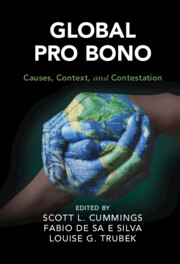Book contents
- Global Pro Bono
- Cambridge Studies in Law and Society
- Global Pro Bono
- Copyright page
- Contents
- Contributors
- Chapter One What Is Global about Pro Bono and What Is Global Pro Bono About?
- Part One The Americas
- Part Two Europe
- Part Three OCEANIA
- Part Four Africa
- Part Five Asia
- Index
- Cambridge Studies in Law and Society
Chapter One - What Is Global about Pro Bono and What Is Global Pro Bono About?
Published online by Cambridge University Press: 06 May 2022
- Global Pro Bono
- Cambridge Studies in Law and Society
- Global Pro Bono
- Copyright page
- Contents
- Contributors
- Chapter One What Is Global about Pro Bono and What Is Global Pro Bono About?
- Part One The Americas
- Part Two Europe
- Part Three OCEANIA
- Part Four Africa
- Part Five Asia
- Index
- Cambridge Studies in Law and Society
Summary
The principle and practice of pro bono – volunteer legal services for poor and other marginalized groups – is an increasingly important feature of justice systems around the world. A quarter century ago, organized pro bono programs were a rarity in the United States and virtually nonexistent elsewhere. Now, in contrast, pro bono has become widely diffused and institutionally central in a growing number of countries throughout the Global North and Global South. In a sign of pro bono’s increasing international profile, PILNet (the Network for Public Interest Law), a key sponsor of the global pro bono movement, has hosted Pro Bono Forums across continents (ten in Europe and five in Asia), bringing together law firm pro bono coordinators, civil society partners, and representatives from more than fifty pro bono organizations in countries as diverse as Indonesia and Italy. In 2013, the Global Pro Bono Network was founded as a consortium of pro bono intermediaries and now includes 52 organizations in 34 countries. A 2016 survey of large-firm pro bono, covering 64,500 lawyers from 130 law firms in 75 countries, showed lawyers contributed 2.5 million pro bono hours over a 12-month period, with an annual average of 39.2 hours per lawyer. Once confined to the professional margins, pro bono now occupies a central position in the global access-to-justice movement.
- Type
- Chapter
- Information
- Global Pro BonoCauses, Context, and Contestation, pp. 1 - 74Publisher: Cambridge University PressPrint publication year: 2022



